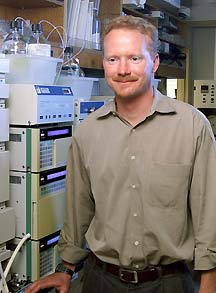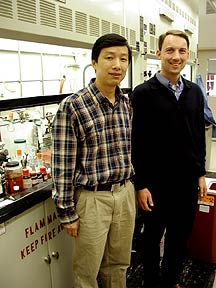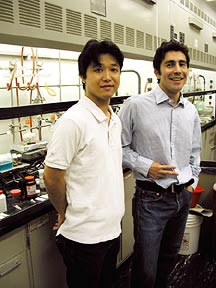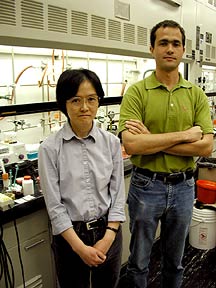Catalysis Made Easy
By Jason Socrates Bardi
Join
we together, for the public good.
——William Shakespeare, Henry VI, Part 2
Synthetic reactions can be noteworthy for their originality,
using chemicals in ways nobody has done before, for their
simplicity, making compounds easier than anybody has ever
done, or for their selectivity, combining molecules to preferentially
form one stereoisomer over another.
Or reactions can be noteworthy for being original, easy,
and selective. And those are just the sort of reactions that
interest a team of chemists at The Scripps Research Institute
(TSRI), led by Carlos Barbas, professor in the Department
of Molecular Biology and investigator in the TSRI Skaggs Institute
for Chemical Biology.
Using novel aldehyde chemistry and the amino acid proline
as a catalyst, members of the team were able to selectively
synthesize a number of compounds, including novel functionalized
amino acids and derivatives of those compounds, which are
useful pharmaceutically.
"We have taken L-proline and we can use that to make a whole
family of other, optically pure amino acids using very simple
chemistry," says Barbas, who holds the Janet and Keith Kellogg
II Chair in Molecular Biology.
"The products would be quite valuable synthetically, because
they can be converted into b-lactams
and [other] antibiotics or unusual amino acids, which are
common to HIV protease inhibitors," he adds.
Add, Stir, and Extract
"Our concept is operationally simple—it's a stir and
mix approach," says Barbas' former research associate Wolfgang
Notz. "[And it] allows us to synthesize highly stereospecifically
functionalized amino acids."
In fact, nothing could be simpler: take a few common chemicals
off the shelf—imines, aldehydes, and ketones—and
throw them into a pot with a benign organic solvent, like
EtOAc, and the amino acid proline, and stir for a few hours
at room temperature.
"You can start a reaction in the morning, and in the afternoon
[isolate the product]," says Assistant Professor Guofu Zhong,
who made several compounds using the methodology. "Some reactions
take a couple of hours, and some go overnight."
"In some cases, you just run your filtrate through a column
and you get your product," says Armando Cordova.
"And," adds Juan Betancort, who studied the intermediates
in the reactions and did some synthetic manipulations of the
final products to compare them with other, known structures.
"We got high enantioselectivity and high yield."
Enantioselectivity is a very important consideration in
industrial chemistry because nature itself is chiral. All
the basic molecules of life—proteins, DNA, and carbohydrates—are
chiral molecules. The subunits from which they are made have
non-superimposeable mirror image "enantiomers," which are
like right and left hands. Without the correct enantiomeric
subunit, many of these basic chemicals of life will not function.
Likewise, many drugs must also be of correct chirality in
order to function. Indeed, in some cases, the wrong enantiomer
can be toxic.
Pharmaceuticals and other commercially produced chemicals
usually must be enantiomerically pure to be safe. While a
drug, for instance, may return our bodies to good health,
its enantiomer may be pure poison. Selectivity is important
in chemical synthesis because often synthetic reactions will
produce a racemic mixture—composed of pairs of (various)
enantiomeric forms, and separating the right one out later
may be expensive, difficult, or impossible.
The synthesis enables access to functional amino acids and
novel amino acids with very high selectivity, in excess of
99 percent of the desired enantiomer, and yields around 80
percent—the amount of product generated from starting
material.
"This reaction should have a high impact [in the field],"
says Shin-ichi Watanabe.
1 | 2 |

|

Professor Carlos Barbas III, Janet and
Keith Kellogg II Chair in Molecular Biology and Investigator
in The Skaggs Institute of Chemical Biology. Photo
by Biomedical Grpahics.

Assistant Professor Guofu Zhong (left),
and former Research Associate Wolfgang Notz.

Research Associates Shin-ichi Watanabe
(left), and Armando Córdova.

Assistant Professor Fujie Tanaka (left),
and Research Associate Juan M. Betancort. Photo
by Kevin Fung.
|

